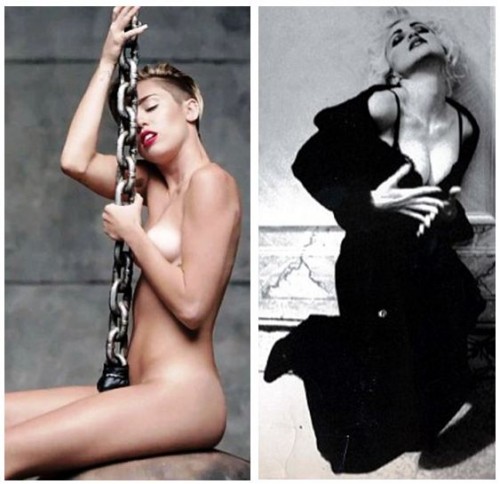In 1990 I was still an American Culture major in college, but I was getting ready to jump ship for sociology. That’s when Madonna’s “Justify My Love” video was banned by MTV, which was a thing people used to use to watch videos. And network TV used to be a major source of exposure.
I was watching when Madonna went on Nightline for an interview. The correspondent intoned:
…nudity, suggestions of bisexuality, sadomasochism, multiple partners. Finally, MTV decided Madonna has gone to far.
They showed the video, preceded by a dire parental warning (it was 11:30 p.m., and there was no way to watch it at any other time). In the interview, Forrest Sawyer eventually realize he was being played:
Sawyer: This was a win-win for you. If they put the video on, you would get that kind of play. And if they didn’t you would still make some money. It was all, in a sense, a kind of publicity stunt. … But in the end you’re going to wind up making even more money than you would have.
Madonna: Yeah. So, lucky me.
The flap over Miley Cyrus completely baffles me. This is a business model (as artistic as any other commercial product), and it hasn’t changed much, just skinnier, with more nudity and (even) less feminism. I don’t understand why this is any more or less controversial than any other woman dancing naked. Everyone does realize that there is literally an infinite amount of free hardcore porn available to every child in America, right? There is no “banning” a video. (Wrecking Ball is pushing 250 million views on YouTube.)

No one is censoring Miley Cyrus — is there some message I’m missing? When she talked to Matt Lauer he asked, “Are you surprised by the attention you’re getting right now?” And she said, “Not really. I mean, it’s kind of what I want.”
I think the conversation has slid backward. In Lisa Wade’s excellent comment, she draws on a 1988 article, “Bargaining With Patriarchy,” which concluded:
Women strategize within a set of concrete constraints, which I identify as patriarchal bargains. Different forms of patriarchy present women with distinct “rules of the game” and call for different strategies to maximize security and optimize life options with varying potential for active or passive resistance in the face of oppression.
I think it applies perfectly to Miley Cyrus, if you replace “security” and “life options” with “celebrity” and “future island-buying potential.” Lisa is 1,000-times more plugged in to kids these days than I am, and the strategies-within-constraints model is well placed. But that article is from 1988, and it applies just as well to Madonna. So where’s the progress here?
Interviewed by Yahoo!, Gloria Steinem said, “I wish we didn’t have to be nude to be noticed … But given the game as it exists, women make decisions.” That is literally something she could have said in 1990.
The person people are arguing about has (so far) a lot less to say even than Madonna did. When Madonna was censored by MTV, Camile Paglia called her “the true feminist.”
She exposes the puritanism and suffocating ideology of American feminism, which is stuck in an adolescent whining mode. Madonna has taught young women to be fully female and sexual while still exercising total control over their lives. She shows girls how to be attractive, sensual, energetic, ambitious, aggressive and funny — all at the same time.
When Miley Cyrus caused a scandal on TV, Paglia could only muster, “the real scandal was how atrocious Cyrus’ performance was in artistic terms.”
Madonna was a bonafide challenge to feminists, for the reasons Paglia said, but also because of the religious subversiveness and homoerotic stuff. Madonna went on, staking her claim to the “choice” strand of feminism:
I may be dressing like the typical bimbo, whatever, but I’m in charge. You know. I’m in charge of my fantasies. I put myself in these situations with men, you know, and… people don’t think of me as a person who’s not in charge of my career or my life, okay. And isn’t that what feminism is all about, you know, equality for men and women? And aren’t I in charge of my life, doing the things I want to do? Making my own decisions?
And she embraced some other feminist themes. When Madonna was asked on Nightline, “Where do you draw the line?” she answered, “I draw the line with violence, and humiliation and degradation.”
I’m not saying there hasn’t been any progress since 1990. It’s more complicated than that. On matters of economic and politics gender has pretty well stalled. The porn industry has made a lot of progress. Reported rape has become less common, along with other forms of violence.
But — and please correct me if I’m wrong — I don’t see the progress in this conversation about whether it’s feminist or anti-feminist for a women to use sex or nudity to sell her pop music. As Lisa Wade says, “Because that’s what the system rewards. That’s not freedom, that’s a strategy.” So I would skip that debate and ask whether the multi-millionaire in question is adding anything critical to her product, or using her sex-plated platform for some good end. Madonna might have. So far Miley Cyrus isn’t.
Cross-posted at Family Inequality and Pacific Standard.
Philip N. Cohen is a professor of sociology at the University of Maryland, College Park, and writes the blog Family Inequality. You can follow him on Twitter or Facebook.























